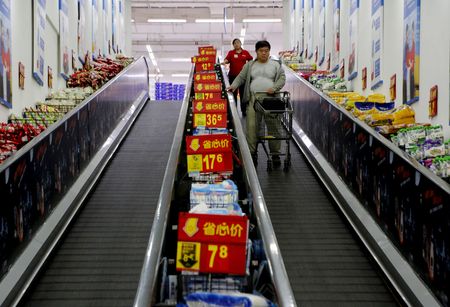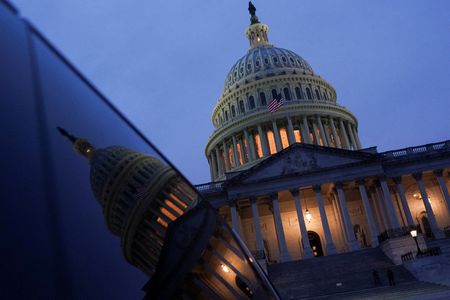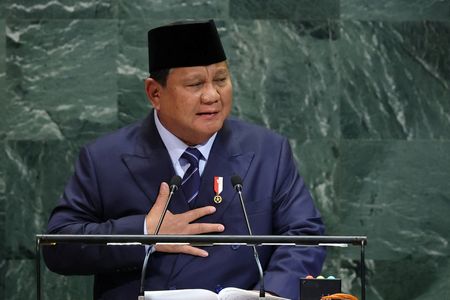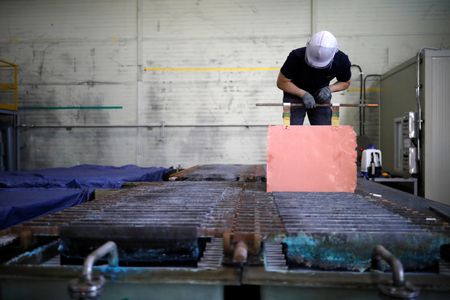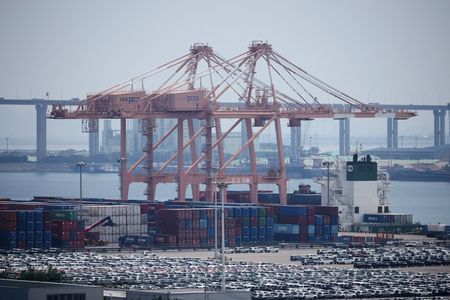BEIJING (Reuters) -Deflationary pressures persisted in China, with both consumer and producer prices falling in September, supporting the case for more policy measures as a prolonged property market slump and trade tensions weigh on confidence.
While China’s export growth rebounded in September, renewed trade measures and threats from Beijing and Washington have rekindled concerns about jobs and further deflation. Policymakers have so far refrained from launching major stimulus, wary of creating a stock market bubble which could end in a repeat of the 2015 crash.
Producer prices (PPI) in September fell 2.3% from a year earlier, narrowing from a 2.9% fall in August, National Bureau of Statistics (NBS) data showed on Wednesday. The decline was the smallest in seven months, helped by government efforts to curb price competition, and matched forecasts in a Reuters poll.
The consumer price index (CPI) dipped 0.3% last month from a year earlier, less than a 0.4% fall in August and compared with a 0.2% fall in a Reuters poll of economists.
“We continue to expect both CPI and PPI to stay in deflation this year and next,” said Zichun Huang, China economist at Capital Economics.
“Policymakers are now taking deflation more seriously. But we doubt that supply-side solutions they are proposing will succeed without substantial demand-side support,” she said.
Food prices fell 4.4% year-on-year, with the price of pork tumbling 17% despite recent government calls for leading hog producers to cut output. Food prices fell 4.3% in August.
Core inflation, which excludes volatile food and fuel prices, was 1% in September from a year earlier, accelerating from 0.9% in August and hitting a 19-month high.
On a monthly basis, CPI was up 0.1%, versus no change in August, and below a forecast 0.2% increase.
The combination of the Mid-Autumn festival and the National Day holiday failed to arrest a downtrend in holidaymakers’ average spending, as cautious consumers were wary of discretionary expenses amid a weak job market and continued property sector downturn.
Lynn Song, chief Greater China economist at ING, said slowing momentum in the third quarter and another month of deflation suggest monetary policy easing remains on the table.
“November, consequently, remains an interesting window to watch for potential easing,” leaving the central bank with ammunition to support markets if trade talks do not go well, Song said.
Authorities announced in May a raft of stimulus measures, including interest rate cuts and a major liquidity injection, and the central bank vowed in late September to step up policy support. But major stimulus measures would also risk overheating the stock market, creating a dilemma for policymakers.
Factory-gate prices have fallen since October 2022 but declines have lessened in recent months due to the government’s calls for key sectors to scale back cut-throat competition. A prolonged price war in the auto sector, for instance, has taken a toll on major automakers’ bottom lines.
While the government’s campaign to fight against price competition in key industries helps manufacturers, a fresh tit-for-tat showdown between the world’s two largest economies dampens hopes for a sustained trade deal.
(Reporting by Zhang Yukun, Qiaoyi Li and Ryan Woo; Editing by Jacqueline Wong)

